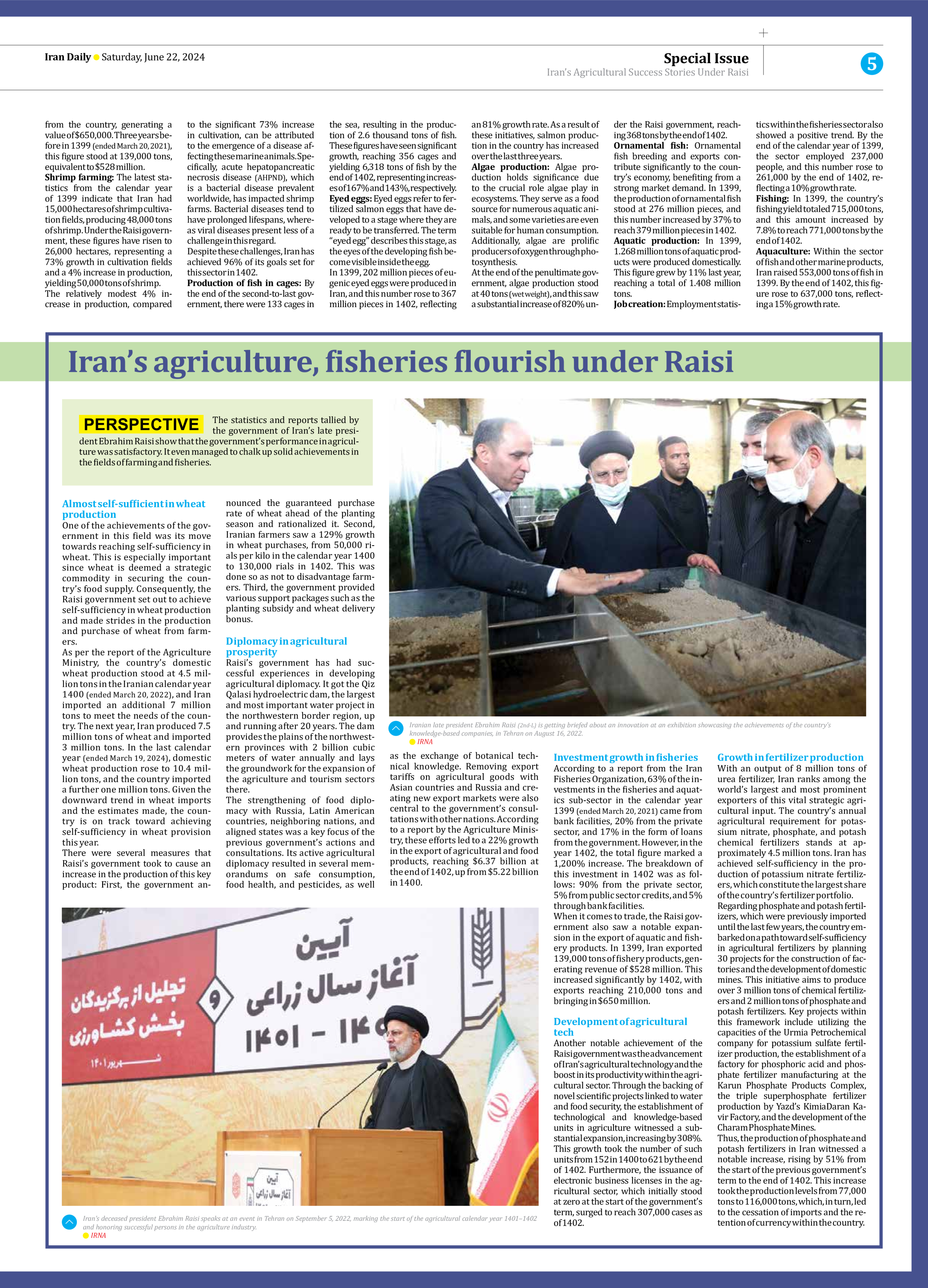
Iran’s agriculture, fisheries flourish under Raisi
The statistics and reports tallied by the government of Iran’s late president Ebrahim Raisi show that the government’s performance in agriculture was satisfactory. It even managed to chalk up solid achievements in the fields of farming and fisheries.
Almost self-sufficient in wheat production
One of the achievements of the government in this field was its move towards reaching self-sufficiency in wheat. This is especially important since wheat is deemed a strategic commodity in securing the country’s food supply. Consequently, the Raisi government set out to achieve self-sufficiency in wheat production and made strides in the production and purchase of wheat from farmers.
As per the report of the Agriculture Ministry, the country’s domestic wheat production stood at 4.5 million tons in the Iranian calendar year 1400 (ended March 20, 2022), and Iran imported an additional 7 million tons to meet the needs of the country. The next year, Iran produced 7.5 million tons of wheat and imported 3 million tons. In the last calendar year (ended March 19, 2024), domestic wheat production rose to 10.4 million tons, and the country imported a further one million tons. Given the downward trend in wheat imports and the estimates made, the country is on track toward achieving self-sufficiency in wheat provision this year.
There were several measures that Raisi’s government took to cause an increase in the production of this key product: First, the government announced the guaranteed purchase rate of wheat ahead of the planting season and rationalized it. Second, Iranian farmers saw a 129% growth in wheat purchases, from 50,000 rials per kilo in the calendar year 1400 to 130,000 rials in 1402. This was done so as not to disadvantage farmers. Third, the government provided various support packages such as the planting subsidy and wheat delivery bonus.
Diplomacy in agricultural prosperity
Raisi’s government has had successful experiences in developing agricultural diplomacy. It got the Qiz Qalasi hydroelectric dam, the largest and most important water project in the northwestern border region, up and running after 20 years. The dam provides the plains of the northwestern provinces with 2 billion cubic meters of water annually and lays the groundwork for the expansion of the agriculture and tourism sectors there.
The strengthening of food diplomacy with Russia, Latin American countries, neighboring nations, and aligned states was a key focus of the previous government’s actions and consultations. Its active agricultural diplomacy resulted in several memorandums on safe consumption, food health, and pesticides, as well as the exchange of botanical technical knowledge. Removing export tariffs on agricultural goods with Asian countries and Russia and creating new export markets were also central to the government’s consultations with other nations. According to a report by the Agriculture Ministry, these efforts led to a 22% growth in the export of agricultural and food products, reaching $6.37 billion at the end of 1402, up from $5.22 billion in 1400.
Investment growth in fisheries
According to a report from the Iran Fisheries Organization, 63% of the investments in the fisheries and aquatics sub-sector in the calendar year 1399 (ended March 20, 2021) came from bank facilities, 20% from the private sector, and 17% in the form of loans from the government. However, in the year 1402, the total figure marked a 1,200% increase. The breakdown of this investment in 1402 was as follows: 90% from the private sector, 5% from public sector credits, and 5% through bank facilities.
When it comes to trade, the Raisi government also saw a notable expansion in the export of aquatic and fishery products. In 1399, Iran exported 139,000 tons of fishery products, generating revenue of $528 million. This increased significantly by 1402, with exports reaching 210,000 tons and bringing in $650 million.
Development of agricultural tech
Another notable achievement of the Raisi government was the advancement of Iran’s agricultural technology and the boost in its productivity within the agricultural sector. Through the backing of novel scientific projects linked to water and food security, the establishment of technological and knowledge-based units in agriculture witnessed a substantial expansion, increasing by 308%. This growth took the number of such units from 152 in 1400 to 621 by the end of 1402. Furthermore, the issuance of electronic business licenses in the agricultural sector, which initially stood at zero at the start of the government’s term, surged to reach 307,000 cases as of 1402.
Growth in fertilizer production
With an output of 8 million tons of urea fertilizer, Iran ranks among the world’s largest and most prominent exporters of this vital strategic agricultural input. The country’s annual agricultural requirement for potassium nitrate, phosphate, and potash chemical fertilizers stands at approximately 4.5 million tons. Iran has achieved self-sufficiency in the production of potassium nitrate fertilizers, which constitute the largest share of the country’s fertilizer portfolio.
Regarding phosphate and potash fertilizers, which were previously imported until the last few years, the country embarked on a path toward self-sufficiency in agricultural fertilizers by planning 30 projects for the construction of factories and the development of domestic mines. This initiative aims to produce over 3 million tons of chemical fertilizers and 2 million tons of phosphate and potash fertilizers. Key projects within this framework include utilizing the capacities of the Urmia Petrochemical company for potassium sulfate fertilizer production, the establishment of a factory for phosphoric acid and phosphate fertilizer manufacturing at the Karun Phosphate Products Complex, the triple superphosphate fertilizer production by Yazd’s KimiaDaran Kavir Factory, and the development of the Charam Phosphate Mines.
Thus, the production of phosphate and potash fertilizers in Iran witnessed a notable increase, rising by 51% from the start of the previous government’s term to the end of 1402. This increase took the production levels from 77,000 tons to 116,000 tons, which, in turn, led to the cessation of imports and the retention of currency within the country.







